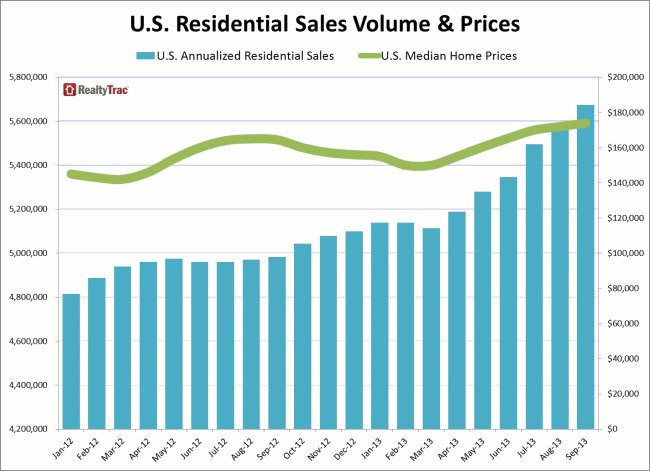There was a substantial increase in September in the purchasing activity of what it called institutional investors RealtyTrac said today. Persons or institutions who have purchased 10 or more residential properties in the last 12 months accounted for 14 percent of all residential sales in September, up 3 percentage points from August and from September 2012. This was the highest level of such institutional investment since RealtyTrac started tracking those purchases in January 2011.
Institutional buyers purchased 25 percent of properties sold in Georgia and Nevada. These investors were also active in Missouri with a 17 percent share, Arizona (16 percent), Illinois and Texas (14 percent and 13 percent respectively).

"The housing market continues to skew in favor of investors, particularly deep-pocketed institutional investors, and other buyers paying with cash," said Daren Blomquist, vice president at RealtyTrac. "While the institutional investors are pulling back their purchases in many of the higher-priced markets - places like San Francisco, Washington, D.C., New York, Seattle and Sacramento - they are continuing to ramp up purchases in markets where median prices are still below $200,000 - places like Jacksonville, Atlanta, Charlotte, St. Louis and Dallas. The availability of distressed inventory also makes a difference. For example, institutional investor purchases have rebounded in Las Vegas corresponding to a recent rebound in foreclosure activity there.
RealtyTrac's U.S. Residential & Foreclosure Sales Report estimates that home sales increased nationally by 2 percent in September. Sales of single family homes, condominiums, and townhomes and including both market sales and sales of distressed properties reached an estimated annualized rate of 5,673,249 units in September, 14 percent higher than in September 2012.
Annualized sales volume increased from the previous month in 34 out of the 38 states tracked in the report and was up from a year ago in 35 states. Notable exceptions where annualized sales volume decreased from a year ago were California (-15 percent), Arizona (-11 percent), and Nevada (-5 percent).

Distressed properties accounted for 25 percent of residential sales in September, an increase of 2 percentage points from August and 7 points from a year earlier. Fourteen percent of all sales were short sales and 10 percent were sales of bank-owned real estate. The two categories each had a 9 percent share in August.
Several states had much higher percentages of short sales than the national average including Nevada (32 percent), Florida (30 percent), Ohio (26 percent), Maryland (22 percent), and Tennessee (21 percent). States with the highest percentage of ORE to total residential sales were Nevada (19 percent), Ohio (18 percent) followed by Arizona, Michigan, Illinois, and Georgia with ORE shares of 14 to 16 percent.
"Distressed sales remain persistently high, particularly short sales," Blomquist added. "Markets with the biggest increases in short sales tend to be those where either foreclosure starts or scheduled foreclosure auctions have rebounded in the last 18 months - translating into more motivated short sellers - or those with a still-high percentage of underwater homeowners with negative equity."
The median sales price of residential properties, both distressed and non-distressed was $174,000, up 1 percent from August and 6 percent from a $164,500 median price in September 2012. Distressed properties had a median of $112,000, 41 percent lower than the median for non-distressed properties at $189,000. States with the largest increases in median prices from September 2012 were California (30 percent), Michigan (25 percent), Nevada (23 percent), Georgia (20 percent), and Arizona (20 percent).
All-cash purchases represented 49 percent of all residential sales in September, up from a revised 40 percent in August and up from 30 percent in September 2012.








